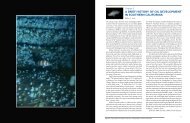checklist (pdf) - The Love Lab - University of California, Santa Barbara
checklist (pdf) - The Love Lab - University of California, Santa Barbara
checklist (pdf) - The Love Lab - University of California, Santa Barbara
Create successful ePaper yourself
Turn your PDF publications into a flip-book with our unique Google optimized e-Paper software.
Family Carangidae — Jacks<br />
Alectis ciliaris (Bloch, 1787). African Pompano. Possibly to 130–150 cm (50–60 in) FL (Smith-Vaniz in<br />
Fischer et al. 1995). Circumglobal; in western Pacific as far north as Japan (Senou in Nakabo 2002) and<br />
southern Kuril Islands (Savinykh 1998); eastern Pacific from Bahia <strong>Santa</strong> Maria (24°40'N, 112°11'W),<br />
southern Baja <strong>California</strong> (SIO 51–65) to Chile (Pequeño 1989), including lower Gulf <strong>of</strong> <strong>California</strong><br />
(Robertson and Allen 2002) and Islas Galápagos (Grove and Lavenberg 1997). Coastal waters, 1–100 m<br />
(3–328 ft; <strong>Lab</strong>oute and Grandperrin 2000).<br />
*Carangoides orthogrammus (Jordan & Gilbert, 1882). Island Trevally or Yellow-spotted Trevally. To 71 cm<br />
(28.0 in) TL (Lieske and Myers 2002). Pacific and Indian oceans; in western Pacific as far north as Cheju<br />
Island, South Korea (Kim et al. 1999); eastern Pacific, Cabo San Lucas (SIO 59–213), Isla Socorro, Isla<br />
San Benedicto, and other oceanic sites (Smith-Vaniz in Fischer et al. 1995). Nearshore areas, 3–170 m<br />
(10–558 ft; Ralston et al. 1986). Sometimes seen as Caranx orthogrammus (e.g., Nelson et al. 2004), but<br />
most researchers classify the species in Carangoides (Eschmeyer 1998 and online editions).<br />
Caranx caballus Günther, 1868. Green Jack. To at least 70 cm (27.6 in) TL (Allen and Robertson 1994).<br />
Monterey Bay, central <strong>California</strong> (Lea and Walker 1995) to Chile (Pequeño 1989), including Gulf <strong>of</strong><br />
<strong>California</strong> (Robertson and Allen 2002), Islas Galápagos (Miller and Lea 1972), and Hawaii (Randall and<br />
Carlson 1999). Surf zone and to 100 m (328 ft) (min.: Carlisle et al. 1960; max.: De La Cruz-Agüero et<br />
al. 1997). Recently as Carangoides caballus.<br />
Caranx caninus Günther, 1867. Pacific Crevalle Jack. To 100 cm (39.4 in) TL (Smith-Vaniz in Fischer et<br />
al. 1995). Warm waters <strong>of</strong> eastern Pacific; San Diego, southern <strong>California</strong> (Miller and Lea 1972) to Isla<br />
Lobos de Tierra (Chirichigno and Vélez 1998), including Gulf <strong>of</strong> <strong>California</strong> (Robertson and Allen 2002),<br />
Islas Galápagos (Grove and Lavenberg 1997), and other <strong>of</strong>fshore islands (Robertson and Allen 2002).<br />
Surface to 350 m (1,148 ft; Smith-Vaniz in Fischer et al. 1995). Caranx hippos is considered a separate<br />
Atlantic and Caribbean species.<br />
Caranx lugubris Poey, 1860. Black Jack. To 99 cm (39 in) TL (Grove and Lavenberg 1997). Circumglobal;<br />
southern Japan (Senou in Nakabo 2002); southern Baja <strong>California</strong> (Smith-Vaniz in Fischer et al. 1995)<br />
to Chile (Pequeño 1989), including lower Gulf <strong>of</strong> <strong>California</strong> (Smith-Vaniz in Fischer et al. 1995) and<br />
Islas Galápagos (Grove and Lavenberg 1997). At depths <strong>of</strong> 3–355 m (10–1,164 ft) (min.: Robertson and<br />
Allen 2002; max.: Ralston et al. 1986).<br />
*Caranx melampygus Cuvier, 1833. Bluefin Jack, Bluefin Trevally, or Blue Trevally. Reported to 100 cm<br />
(39.4 in) TL (Smith-Vaniz in Fischer et al. 1995). Pacific and Indian oceans; southern Japan (Senou<br />
in Nakabo 2002); Cabo San Lucas, southern Baja <strong>California</strong> (Smith-Vaniz in Fischer et al. 1995) to<br />
Isla Gorgona, Colombia (Franke and Acero 1993), including lower Gulf <strong>of</strong> <strong>California</strong> (Smith-Vaniz in<br />
Fischer et al. 1995) and such <strong>of</strong>fshore islands as Islas Galápagos (Grove and Lavenberg 1997). Nearshore<br />
areas, 1–230 m (3–754 ft) (min.: <strong>Lab</strong>oute and Grandperrin 2000; max.: Ralston et al. 1986); juveniles<br />
may inhabit estuaries (Smith and Parrish 2002).<br />
Caranx otrynter Jordan & Gilbert, 1883. Threadfin Jack or Thread Pompano. To 60 cm (23.6 in) TL (Allen<br />
and Robertson 1994). Bahia Magdalena, southern Baja <strong>California</strong> (De La Cruz-Agüero et al. 1994) to<br />
Ecuador (De La Cruz-Agüero et al. 1997), including lower and central Gulf <strong>of</strong> <strong>California</strong> (Robertson<br />
and Allen 2002) and Islas Galápagos (Grove and Lavenberg 1997). Surface to 100 m (328 ft; De La Cruz-<br />
Agüero et al. 1997). Also recently called Carangoides otrynter.<br />
Caranx sexfasciatus Quoy & Gaimard, 1825. Bigeye Crevalle, Bigeye Trevally, or Sixband Jack. To 94 cm<br />
(37.0 in; Lieske and Myers 2002) to 120 cm (47.2 in; Sadovy and Cornish 2000) TL. Pacific and Indian<br />
oceans; southern Japan (Senou in Nakabo 2002); San Diego Bay, southern <strong>California</strong> (Lea and Walker<br />
1995) to Ecuador (Grove and Lavenberg 1997), including lower Gulf <strong>of</strong> <strong>California</strong> (Robertson and Allen<br />
116




